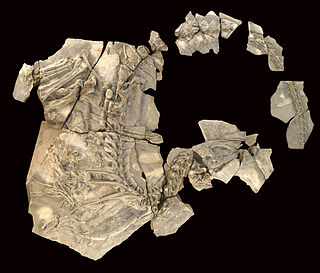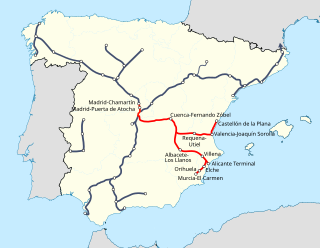
Aeolosaurus is a genus of titanosaurian sauropod dinosaur from the Late Cretaceous Period of what is now South America. Like most sauropods, it would have been a quadrupedal herbivore with a long neck and tail. Aeolosaurus is well known for a titanosaur, as it is represented by the remains of several individuals belonging to at least two species. However, like most titanosaurs, no remains of the skull are known. The holotype of Aeolosaurus rionegrinus consists of a series of seven tail vertebrae, as well as parts of both forelimbs and the right hindlimb. It was discovered in the Angostura Colorada Formation in Argentina, which dates from the Campanian stage of the Late Cretaceous, about 83 to 74 million years ago. The species A. maximus was transferred over to the new genus Arrudatitan in 2021.

Rhabdodon is a genus of ornithopod dinosaur that lived in Europe approximately 70-66 million years ago in the Late Cretaceous. It is similar in build to a very robust "hypsilophodont", though all modern phylogenetic analyses find this to be an unnatural grouping, and Rhabdodon to be a basal member of Iguanodontia. It was large amongst its relatives, measuring 4 m (13 ft) long and weighing 250 kg (550 lb), with some specimens possibly reaching up to 6 m (20 ft) long.

Ampelosaurus is a titanosaurian sauropod dinosaur from the Late Cretaceous Period of what is now France. Its type species is A. atacis, named by Le Loeuff in 1995. Its remains were found in a level dating from 71.5 million years ago representing the early Maastrichtian.

Epachthosaurus was a genus of titanosaurian sauropod dinosaur from the Late Cretaceous. It was a basal lithostrotian titanosaur. Its fossils have been found in Central and Northern Patagonia in South America.

Lithostrotia is a clade of derived titanosaur sauropods that lived during the Early Cretaceous and Late Cretaceous. The group was defined by Upchurch et al. in 2004 as the most recent common ancestor of Malawisaurus and Saltasaurus and all the descendants of that ancestor. Lithostrotia is derived from the Ancient Greek lithostros, meaning "inlaid with stones", referring to the fact that many known lithostrotians are preserved with osteoderms. However, osteoderms are not a distinguishing feature of the group, as the two noted by Unchurch et al. include caudal vertebrae with strongly concave front faces (procoely), although the farthest vertebrae are not procoelous.
Muyelensaurus is a genus of titanosaurian sauropod dinosaur from the Late Cretaceous of Argentina. It was more slender than other titanosaurs. Fossils have been recovered in the Neuquén province of Patagonia and were originally assigned to the Portezuelo Formation but further research showed that these layers belong to the Plottier Formation. The type species is M. pecheni. The name Muyelensaurus first appeared in a 2007 paper by Argentine paleontologists Jorge Calvo of the Universidad Nacional del Comahue and Bernardo González Riga of the Laboratorio de Paleovertebrados, and Brazilian paleontologist Juan Porfiri of the Universidade Federal do Rio de Janeiro.

The La Huérguina Formation is a geological formation in Spain whose strata date back to the Barremian stage of the Early Cretaceous. Las Hoyas is a Konservat-Lagerstätte within the formation, located near the city of Cuenca, Spain. The site is mostly known for its exquisitely preserved dinosaurs, especially enantiornithines. The lithology of the formation mostly consists of lacustrine limestone deposited in a freshwater wetland environment.
The Arcillas de Morella Formation is a geological formation in Spain whose strata date back to the Barremian stage of the Early Cretaceous. Dinosaur remains are among the fossils that have been recovered from the formation.

The Villalba de la Sierra Formation is a Campanian to Maastrichtian geologic formation in Spain. Fossil dinosaur eggs have been reported from the formation, that comprises gypsiferous, grey, argillaceous mudstones and sandstones, deposited in a floodplain environment characterised by high seasonality and variability in water availability.

Opisthocoelicaudiinae is a subfamily of titanosaurian dinosaurs from the Late Cretaceous. It was named by John McIntosh in 1990. Opisthocoelicaudiines are known from Mongolia, Argentina, and the United States. Two genera were assigned to Opisthocoelicaudiinae by Gonzalez et al. (2009): Alamosaurus and Opisthocoelicaudia, a conclusion also found by Díez Díaz et al. (2018). The hands of opisthocoelicaudiines lacked wrist bones and phalanges.

Paludititan is a genus of titanosaurian sauropod dinosaur which lived in the area of present Romania during the Late Cretaceous. It existed in the island ecosystem known as Hațeg Island.

Concavenator is a genus of carcharodontosaurid dinosaur that lived in Spain during the Early Cretaceous epoch, about 125 million years ago. The genus contains a single species, Concavenator corcovatus named and described in 2010 from a nearly complete skeleton collected from Las Hoyas fossil site of La Huérguina Formation.

The Madrid–Levante high-speed network is a network of high-speed rail lines that connects Madrid with the Mediterranean coast of the Levante Region, specifically with Castilla-La Mancha, the Valencian Community and the Murcia Region autonomous communities.
Lohuecotitan is an extinct genus of titanosaurian sauropod dinosaur which lived during the Late Cretaceous in Spain. The only species known in the genus is Lohuecotitan pandafilandi, described and named in 2016.

Lohuecosuchus is an extinct genus of allodaposuchid eusuchian crocodylomorph that lived during the Late Cretaceous in what is now Spain and southern France.

Agaresuchus is an extinct genus of allodaposuchid eusuchian crocodylomorph from the Late Cretaceous (Campanian-Maastrichtian) of Spain. It includes two species, the type species A. fontisensis, and A. subjuniperus, which was originally named as a species of the related genus Allodaposuchus. However, it has been proposed that both species may instead belong to the genus Allodaposuchus.

Lirainosaurinae is a subfamily of lithostrotian titanosaur sauropods from the Late Cretaceous of France, Spain, and Romania.

Oceanotitan is a genus of sauropod dinosaur known from the Upper Jurassic Lourinha Formation of Portugal. It is represented by a single specimen consisting of several tail vertebrae and appendicular bones. It contains one species, Oceanotitan dantasi. Oceanotitan is classified as possibly one of the earliest members of the Somphospondyli, a group of sauropods that includes the titanosaurs.

Garumbatitan is an extinct genus of somphospondylan sauropod dinosaur from the Cretaceous Arcillas de Morella Formation of Spain. The genus contains a single species, G. morellensis, known from multiple partial skeletons.




























